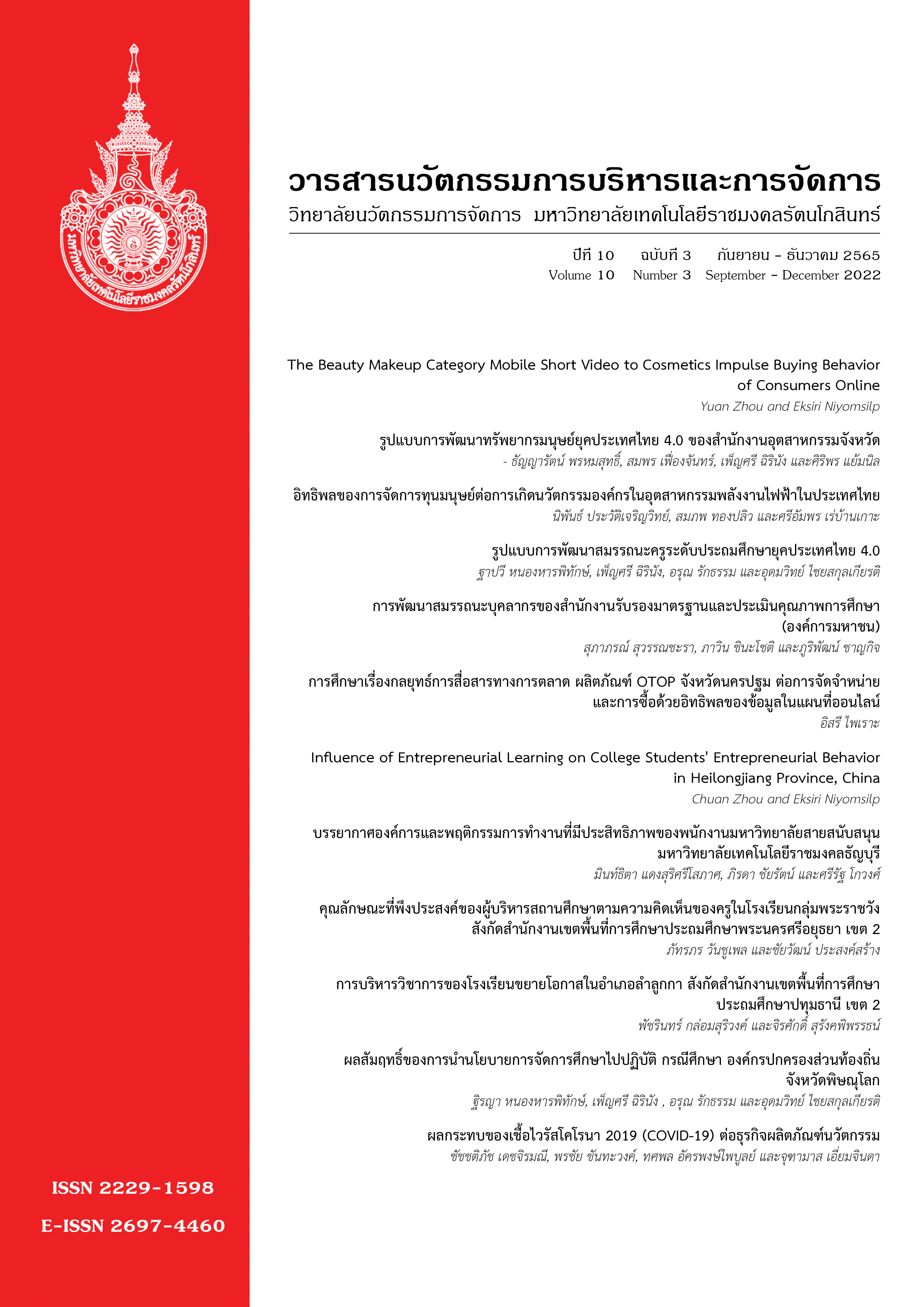Effects of Coronavirus Disease 2019 (COVID-19) on Innovative Product Business
Main Article Content
Abstract
The implications of this paper are to suggest to marketers the long-term consumer behavioral shifts we could see from the COVID-19 pandemic of 2021, and the resulting shifts in consumer behavior. On global consumer traits, buying patterns, global interconnectedness, and purchase behavior, and other marketing activities. Even if cannot prevent dangerous viruses from emerging, we should prepare to dampen their effects on society. E-commerce is become a substitute source and is considered top in this condition, and e-retailers provide goods that usually consumers bought in superstores traditionally. The Coronavirus intensely transformed global trends. These variations were causative to the high inadvertent and look the second funds, to continue the business again. Therefore, the pattern of marketing is changing by doing marketing online. The Academic Article can indicate that social media influencers do not affect online purchase intentions.
Article Details

This work is licensed under a Creative Commons Attribution-NonCommercial-NoDerivatives 4.0 International License.
ข้อความและบทความในวารสารนวัตกรรมการบริหารและการจัดการ เป็นแนวคิดของผู้เขียน ไม่ใช่ความคิดเห็นและความรับผิดชอบของคณะผู้จัดทำ บรรณาธิการ กองบรรณาธิการ วิทยาลัยนวัตกรรมการจัดการ และมหาวิทยาลัยเทคโนโลยีราชมงคลรัตนโกสินทร์
ข้อความ ข้อมูล เนื้อหา รูปภาพ ฯลฯ ที่ได้รับการีพิมพ์ในวารสารนวัตกรรมการบริหารและการจัดการ ถือเป็นลิขสิทธิ์ของวารสารนวัตกรรมการบริหารและการจัดการ หากบุคคลใดหรือหน่วยงานใดต้องการนำทั้งหมดหรือส่วนหนึ่งส่วนใดไปเผยแพร่ต่อหรือกระทำการใดๆ จะต้องได้รับอนุญาติเป็นลายลักษณ์อักษรจากวารสารนวัตกรรมการบริหารและการจัดการก่อนเท่านั้น
References
Asmelash, L., & Cooper, A. (2020). Nearly 80% of hotel rooms in the US are empty, according to new data.
fromhttps://edition.cnn.com/2020/04/08/us/hotel-rooms-industrycoronavirus-trnd/index.htm.
Bajaj, K. & Mehendale, S. (2016). Food - Delivery Start-Ups: In Search of the Core.
Prabandhan: Indian Journal of Management, 9(10).
Bao, Y.; Chen, X.; Zhou, K. Z.(2012). External learning, market dynamics, and radical innovation: Evidence from
China’s high-tech firms. Journal of Business Research, 65, 1226-1233.
Bhatti A., Akram H., Muhammad Basit H., Ahmed Usman K., Naqvi Syeda M., and Bilal M. (2020). E-commerce
trends during COVID-19 Pandemic. International Journal of Future Generation Communication and
Networking, 13(2), 1449-1452.
Cacioppo, J. T., & Hawkley, L. C. (2009). Perceived social isolation and cognition.
Trends in Cognitive Sciences, 13(10), 447–454.
Campbell, A. M. (2020). An increasing risk of family violence during the Covid-19 pandemic: Strengthening
community collaborations to save lives. Forensic Science International: Reports, 100089.
Chaivichayachat, S., Leingchan, R. (2020). Covid-19 Impact on the Thai Economy and Vulnerability of Thai
Firms. Research Intelligence Krungsri Research, April(2020), 1-8.
Chai, L.T., Yat, D.N.C. (2019). Online Food Delivery Services: Making Food Delivery the New Normal.
Journal of Marketing Advances and Practices, 1, 62-77.
Chen, N.H.; Hung, Y.W. (2015). Online shopping orientation and purchase behavior for high-touch products.
International Journal of Electronic Commerce Studies, 6, 187–202
Eti Ismat. A., Abu Horaira. M., and Murshedul Bari M. (2021). Power and stimulus of social media marketing
on consumer purchase intention in Bangladesh during the COVID-19.
International journal of research in business and social science, 10(1). pp. 28-37
Funk, S., Gilad, E., Watkins, C., & Jansen, V. A. (2009). The spread of awareness and its impact on epidemic
outbreaks. Proceedings of the National Academy of Sciences, 106(16), 6872-6877.
Han, S. H., Cho, H. Y., & Yang, H. C. (2014). Why do we pay for advertising models: Suggestions for maximizing
advertising effectiveness. The Journal of Business Economics and Environmental Studies, 4(1), 15-23.
Hwang, S., & Jung, H. (2018). The interactive effects of motivation and contingent rewards on employee
creativity. The Journal of Industrial Distribution & Business, 9(7), 71-82.
Jagdish Sheth. (2020). Impact of Covid-19 on consumer behavior: Will the old habits return or die.
Journal of Business Research, 117, 280-283.
Jamal Bayad. (2020). Impact of COVID-19 on consumer buying behavior toward online shopping in Iraq.
Economic Studies Journal, 18, 267-280.
Jaworski, B., Kohli, A. K., & Sahay, A. (2000). Market-driven versus driving markets.
Journal of the Academy of Marketing Science, 28(1), 45–54.
Jiang, L.A., Yang, Z., Jun, M., 2013. Measuring consumer perceptions of online shopping convenience.
Journal of Service Management, 24 (2), 191-214.
Jorda, O., Singh, S. R., & Taylor, A. M. (2020). Longer-run economic consequences of pandemics
(Report no. w26934). National Bureau of Economic Research.
Katawetawaraks, C., & Wang, C. L. (2011). Online shopper behavior: influences of online shopping decision,
Asian Journal of Business Research, 1(2), 66-74.
Ngai, E. W. (2007). Gunasekaran, A. A review for mobile commerce research and applications.
Decision Support Systems, 43, 3–15
Norman, D.A.; Verganti, R. (2014). Incremental and radical innovation: Design research vs. technology and
meaning change. Design Issues, 2014, 30(1), 78-96.
Nowland, R., Necka, E. A., & Cacioppo, J. T. (2018). Loneliness and social internet use: Pathways to
reconnection in a digital world? Perspectives on Psychological Science, 13(1), 70-87.
Rodgers, S. (2004), The Effects of Sponsor Relevance on Consumer Reactions to Internet Sponsorships.
Journal of Advertising, 32(4), 67-76.
Roggeveen, A. L. (2020). How the COVID-19 Pandemic May Change the World of Retailing.
Journal of Retailing, 96 (2), 169-171.
Sorescu, A.B.; Chandy, R.K.; Prabhu, J. C. (2003). Sources and financial consequences of radical innovation:
Insights from pharmaceuticals. Journal of marketing, 67(4), 82-102.
Tucker, H. (2020). Coronavirus bankruptcy tracker: These major companies are failing amid the shutdown.
from https://www.forbes.com/sites/hanktucker/2020/05/03/ coronavirus-bankruptcy-tracker-these-
major-companies-are-failing-amid-theshutdown/#5649f95d3425.
Wahyuni, S. (2019). The influence of product innovation, brand image, and physical evidence to purchase
decision and WOM of Starbucks in Jakarta. Middle East Journal of Management, 6(2), 123-138.
Zwanka, R. J. & C. BUFF. (2020). COVID-19 Generation: A Conceptual Framework of the Consumer Behavioral
Shifts to Be Caused by the COVID-19 Pandemic. Journal of International Consumer Marketing, 1-10.


